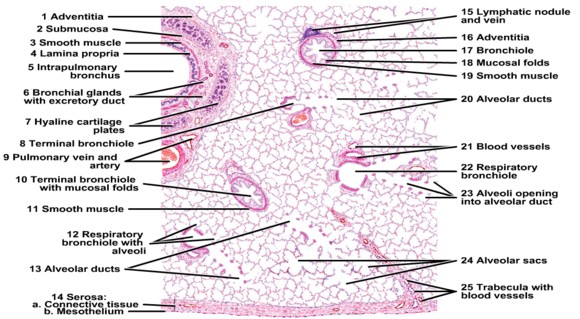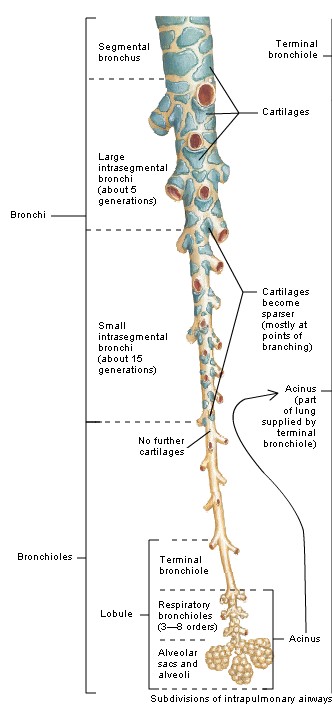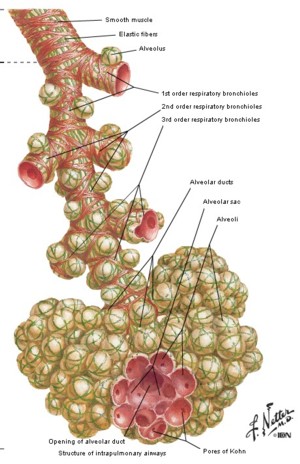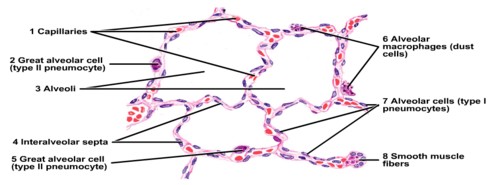
The Respiratory System
Life is often thought of as synonymous with breathing. As the story goes, God gave Adam the "breath of life". The lungs are the cornerstone of the respiratory system, providing the space for gas exhange to occur between the atmosphere and the blood.
The drive to breathe comes from the need to remove CO2, not to inhale oxygen.
Inspired air travels through the nose and pharynx, where it is heated, humidified, and filterd of particles greater than 10 um in diameter. Air passes through the open larynx and through the trachea, which is 10-12 mm in diameter and held in shape by U-shaped cartilage rings.
Blood pumped from the right ventricle crosses the pulmonary valve and enters the pulmonary trunk, which divides into the two pulmonary arteries. As blood enters pulmonary capillaries, it flows past air-filled alveoli and exchanges carbon dioxide for fresh oxygen. This new blood flows along pulmonary veins and enters the left atrium.
The Lungs
The lungs are located in the thorax. Their principle role is in gas exchange, but they have other functions as well, including:
- blood reservoir, filter against emboli, metabolic location of enzymes such as angiotensin-converting enzyme, thermal reservoir, protecting against heat loss.
The right lung has 3 lobes, making up 55% of total lung capacity. The left has two lobes.
The airways conduct air to and from the parenchyma, which is where gas exchange takes place. Ventilation is the mechanical movement of the respiratory system. Respiratory control determines breathing rate and quality. Gas transfer throughout the body occurs via the vasculature, and finally cellular respiration is the metabolism of carbohydrates and other molecules, using oxygen, and generating carbon dioxide during ATP synthesis.
put pulmonary blood flow somewhere
The bronchial circulation supplies the airways, and comes off the aorta.

As you can see, the pleural lining is quite thin - only a few cells thick.
Airways
Respiratory Airways
There are perhaps 23 levels of bifurcation of the lung's airways.
Bronchi
- rigid due to cartilage
Bronchioles
- contain smooth muscle;contractile
- location of asthma action
Distal Airways
- elastic
- collapsible
- site of ventilation
Lobules are the terminal clusters of alveolar sacs.
Alveoli

The 300 million alveoli, with a surface area of 50-100 m2 per lung, are the gas-exchanging structures of the lungs.They begin as outpouches of respiratory bronchioles but are found in greatest number in alveolar sacs.
Alveoli are in intimate contact with the endothelial cells of the lung's extensive capillary system.
The thin Type I pneumocytes make up most of the alveolar walls, while type II pneumocytes (5% if the cells) secrete surfactant to reduce surface tension and keep the alveoli inflated. Type II pneumocytes are capable of regeneration and differention into type I cells following injury.
Macrophages live in alveoli.

Connective Tissue
The interstitium consists of the basement membrane of alveolar and endothelial cells - fused in the thinnest regions - collagen fibres, elastic fibres, proteoglycans, fibroblasts, mast cells, and occasional lymphocytes and monocytes.